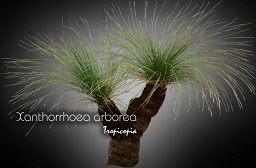Table of contents
Grass tree

Latin Name: Xanthorrhoea arborea
Category: Other
Family: Liliaceae
Origin: Australia
Climate: Arid Tropical
Growing Zones: 11, 9
Care Instructions
The Grass tree (Xanthorrhoea arborea) is a arid tropical plant that originates from Australia. This other plant belongs to the Liliaceae family and is well-suited for growing in USDA zones 11, 9.
Complete Care Guide for Grass Tree (Xanthorrhoea arborea)
Watering Requirements
The Grass Tree (Xanthorrhoea arborea) is a drought-tolerant plant that thrives in its native Australian environment, where rainfall can be sporadic. When establishing a new plant, it is crucial to provide regular watering to help it acclimate. Water the Grass Tree deeply once a week during the first few months after planting. Once established, reduce watering to once every two to three weeks, depending on rainfall and temperature. It is essential to allow the soil to dry out between watering sessions, as overwatering can lead to root rot. During prolonged dry spells, a deep watering every few weeks can help maintain its health, but be cautious not to saturate the soil.
Light Conditions
Grass Trees prefer full sun to partial shade, making them ideal for sunny gardens or landscapes. They thrive in bright, direct sunlight for at least six hours a day, which promotes healthy growth and flowering. However, in extremely hot climates, providing some afternoon shade can help prevent leaf scorch. If grown indoors, place the Grass Tree near a south-facing window where it can receive ample sunlight. Insufficient light can lead to leggy growth and reduced flowering, so ensure that your Grass Tree is positioned to receive the light it needs to flourish.
Soil Preferences
The ideal soil for Grass Trees is well-draining, sandy, or loamy soil that mimics their natural habitat. They prefer slightly acidic to neutral pH levels (around 6.0 to 7.0). To improve drainage, consider mixing in coarse sand or perlite with your potting mix if planting in containers. Grass Trees are sensitive to heavy clay soils, which can retain too much moisture and lead to root issues. Fertilization should be minimal; a slow-release, low-phosphorus fertilizer can be applied in early spring to promote growth, but avoid over-fertilizing, as this can harm the plant.
Pests and Diseases
Grass Trees are generally resilient and not prone to many pests or diseases. However, they can occasionally be affected by scale insects or mealybugs, which can be identified by the sticky residue they leave on the leaves or the presence of white cotton-like masses. To manage these pests, you can wipe the leaves with a damp cloth or use insecticidal soap for more severe infestations. Fungal diseases can occur if the plant is overwatered or if humidity levels are too high, leading to root rot or leaf spots. Ensure proper watering practices and good air circulation to prevent these issues. Regularly inspect your Grass Tree for any signs of distress to catch problems early.
Special Care Tips
To maintain the health and beauty of your Grass Tree, consider the following special care tips: First, avoid disturbing the root system, as Grass Trees have a unique root structure that can be sensitive to transplanting. If you need to move your plant, do so with care and ensure you keep as much of the root ball intact as possible. Additionally, during the flowering season, which typically occurs in late spring to early summer, avoid cutting back the flower spikes until they have finished blooming, as this can affect the plant’s energy reserves. Lastly, consider mulching around the base with organic material to help retain moisture and suppress weeds, but keep the mulch away from the trunk to prevent rot. With these care tips, your Grass Tree can thrive and become a stunning focal point in your garden.








